Earliest tomatoes/peppers/melons in your garden
What are the earliest tomatoes, peppers, watermelons, and muskmelons (C. melo) in your garden?
In mine, my earliest tomatoes have been these:
• Chocolate Pear (this is supposed to be 70-days, but 50 to 60 days in my garden)
• Early Girl F1
• Matina
• Solanum cheesmaniae (this seems to be the earliest of all in this list; the others are were all about the same in my garden, depending on the year—maybe 50 to 60 days after the transplant or so, give or take a few)
• Sweet Orange Cherry (this is probably my second earliest, but pretty close to the others that follow it)
My earliest watermelons have been these:
• Blacktail Mountain (the earliest watermelon I've tried)
• Verona (not as early as Blacktail Mountain, but earlier than everything else I've gotten a harvest with)
I'm not sure that I have an earliest muskmelon to report, as far as ripe-enough-to-save-seeds goes, but Metki Dark Green Serpent melon is definitely the earliest I've harvested from—it's an Armenian cucumber, but it seems earlier than the zucchini (and the fruits are potentially larger than zucchini), and very prolific.
My earliest peppers have been these:
• Randy Sine’s Evil Jalapeno
• Jimmy Nardello Italian x Corbaci F1
Comments (54)
digit (ID/WA, border)
6 years agolast modified: 6 years agoI have Early Girl every year but it isn't the earliest. Usually, that's a few Sungold cherries. However, I started some Coyote plants a few years ago and they are very, very early cherries. They volunteered and I decided to leave a few since they were so dang early. Ripe before frost!!! So, I just went with volunteers for another couple of years. Last year, the tractor guy must have been too efficient and not one volunteer showed up!
I decided that this was okay and I'd sow seeds in the garden. This is something that I wanted to do with Golden Nugget, another cherry with breakneck speed in ripening altho not a variety that I like real well. Anyway, I sowed seed and not a single one sprouted. I will be starting the Coyote seed indoors, soon.
Kimberley is a very early tomato. I didn't grow it last year for the first time in about a decade. And, I didn't realize that I used the last of the seed in 2016 without saving any. I'll have to buy again. Bloody Butcher is a very flavorful and early tomato. I think it would be real disappointing not to have them.
Melons - I have no plans to grow Minnesota Midget again. A watermelon variety seems to be off the table of possibilities. My early melons are Diplomat and Goddess, found after several years of trying. This year, I will try Halona but I'm really not sure why. I'm quite happy with Goddess.
Peppers are another challenge. Italian sweets work better than bells altho I will have King of the North again. Corno di Toro was early and the most productive but I really like the Marconis better. The smaller hot peppers that I've grown, the more likely to ripen: Thai Hot work well but, Thai Dragon have done fine and a very early and productive Super Chili is about the best.
Steve
Mokinu thanked digit (ID/WA, border)Deb
6 years agoAlthough I've never grown them, I've heard that Fourth of July tomatoes mature quickly--55 to 68 days.
Mokinu thanked DebRelated Discussions
I want to trade for peppers, tomatoes and melons
Q
Comments (6)take a look at the commercial Burpee pkgs on my trade list to see if there's anything you like. Happy to send any of the Burpees for postage. They're from 2010 but I keep them stored in plastic containers in the frig and I've been using them w/ good germination. P...See MoreIndoor garden, Very Sick Peppers and tomatos
Q
Comments (6)Best insecticide for loopers and other cats is your hand. You would not want to put any insectide on any plant you intend to eat the foliage. Some insecticides can be used on plants that you do not eat the foliage but there is a definate time that you should avoid between treating and eating. This time depends on the plant....See MoreTons of Seeds to trade! Melons, Tomatoes, Peppers and much more!
Q
Comments (2)Hi there, I would live to trade. I am interested in trading for your... lemon cucumber haskap berry sungold select II tomato sun sugar tomato goji berry curled parsley please check out my trade list and send me a private email if you can. Thanks sara...See MorePeppers, Tomatoes, & Melons for trade
Q
Comments (5)AJT, I have Coneflower to trade for some of your melons and watermelon seeds. My email is: aliciacammel@gmail.Com Thank you!...See MoreJerry (Broomfield CO 5)
6 years agoSungold
Early girl is no earlier than most of my larger tomatoes. Cherokee Purple is fairly early often. Kellogg's breakfast too.Mokinu thanked Jerry (Broomfield CO 5)Mokinu
Original Author6 years agolast modified: 6 years agoJerry, what's your soil type? Did you water a lot, a little, or moderately? How much sun? I've heard that Cherokee Purple can be early for some people, but I think this is the first I've heard for Kellogg's Breakfast.
I've been meaning to try Cherokee Purple again. I think my seeds had a mild disease the last time I tried it, and it didn't have good growing conditions. I have tried Indian Zebra (which is the same as Indian Stripe, depending on who you ask), which is supposed to be a lot like Cherokee Purple, but it was very slow growing and not early; I may have watered it too much, though. Cherokee Green Pear did much better for me than Indian Zebra did, with the same watering, and it was midseason. Indian Zebra was midseason and I only got one to a few fruits from it. They were both crowded.
Jerry (Broomfield CO 5)
6 years agoHi Shule,
Raised garden with "created" soil about 10" deep directly on natural soil.
Rough contents:
Eko compost 50%
3 other composts 10%
Coir and peat 15%
Chunky Vermiculite 10%
Expanded Shale 10%
Worm Castings 5%
In the fall, I mix in our collected eggshells and coffee grounds and maybe add a little azomite and fresh work castings and compost. Not much need to fertilize.
My Kellogg's were actually KBX from Harlequin.
In a 4.5 x 12 area, I get 7 tomato plants and 3 bean towers with herbs in between.Mokinu thanked Jerry (Broomfield CO 5)nbm1981
6 years agolast modified: 6 years agoIt's funny how Early Girl never comes in early for anyone - always a mid-season. I have had the same results, but it is generally reliable and is a good all-around tomato.
My earliest fruit ever was Stupice at 52 days; I think it was July 13, 2016 with a transplant date of May 22. I can sometimes get my indoor-grown micro tomatoes to produce ripe fruit within 80-85 days from seed. I start rolling in tomatoes at about 70-75 days. I very rarely have plants that don't produce the first ripe fruit within 75 days. Many 80-90 DTM varieties produce well in advance of their expected dates, at least for me. My plant-out goal each season is the Thursday before Memorial Day (so May 21-27, generally) and I start harvesting in abundance by August 5 or so.
I am always harvesting peppers before the end of June, but I also start them from seed no later than mid-February, so they are already practically mature at transplant time in late May. I will usually remove flowers for the first two weeks while the transplants settle, then let 'em do their thing.
Melons/cukes/zukes I generally start in flats outdoors in early May and transplant after about 3 weeks. Otherwise, I direct sow, often with similar maturity dates. It all depends on the weather. I generally have cucumbers within 55-60 days and melons within 65-70 days.
Mokinu thanked nbm1981Mokinu
Original Author6 years agolast modified: 6 years agoEarly Girl F1 has always been early for us. Last we grew it (in 2014), we had fruit at the end of June (we got bonnieplants.com plants from The Home Depot). We've always gotten plants for that one, though. I haven't tried it from seed, yet. There are ways to start plants to make them earlier (with regard to temperature at a certain growth stage), and the growers may have used such methods.
Early Girl F2+ plants have never been early for me, though (grown from seed), but those aren't true to type anyway.
I've been hoping to try the F1 again, from seed this time, and see how it does. It may just be early in my climate/soil rather than due to how the initial growers started it.
nbm1981
6 years agolast modified: 6 years agoShule, I've grown Hearts of Gold cantaloupe, Sugar Baby watermelon, Prescott Fond Blanc (similar in flavor to cantaloupe) and Snow Leopard honeydew. Most advertise 70-80 days, but Hearts of Gold and Snow Leopard produced very quickly, within 65. Hearts of Gold also produced really well - my records say 6 melons from 1 plant totaling just under 17 pounds. I don't grow melon every season, so I don't have much to compare it to, but I was more than happy with that. Sugar Baby produced 3 on one plant and the others produced 2 each. I will say there is almost nothing better than fresh melon right out of the garden (maybe even warmed slightly by the sun). When perfectly ripe, few flavors compare.
I purchased Minnesota Midget seeds for this season and I may or may not grow it. With the number of tomato and pepper plants I anticipate, I may not have the room. My partner is severely allergic to all types of melon, so I have to be very careful during harvest time. Even touching the skin can be very dangerous for him.
Most seasons I try quite hard for early production, especially with lettuces and greens that I had already started by this time last season, but with work and other household projects going on, I don't need the added stress this season. My plan is to focus more energy on a fall planting than a spring one. I've got a lot more time to plan for fall and it typically transitions more slowly and predictably than spring anyway (with far fewer chances for damaging hail)..
Mokinu thanked nbm1981Mokinu
Original Author6 years agolast modified: 6 years ago@digit
I haven't tried any Charentais melons, yet, but Alvaro F1 is an early one I've wanted to try.
My main reason for not having grown any Charentais types yet is reported fruit size. I like my melons to be 5+lbs. :) Granted, I'm growing Ananas D'Amerique A Chair Verte again, this year, and it's tiny (but it's excellent), but I hope to breed the tinyness out of successive generations (it's the only small melon I'm growing this year—and it's not early, but not excruciatingly late—and only one plant; well, I mean three in one spot). It has a vigorous plant. Maybe Charentais is as tasty or better, though.
I really like the more reddish/pinkish flesh color than is typical of melons that I see in the pictures of Charentais.
digit (ID/WA, border)
6 years agolast modified: 6 years agoThe Charentais are incredibly fragrant when ripe. They don't hold well, are inclined to split, and all that fragrance may not be to everyone's taste. Of course, the fragrance translates into flavor.
I may have had a streak of luck with the Chartenais hybrid Burpee discontinued. I tried both Savor and Alvaro. One or the other, tried twice. Disappointed. They probably just don't like the cool nights.
Kitazawa has a Hakucho Charentais. It's really tiny: "just over 1 pound." Well, that's really tiny for a melon but I guess I already said that ... Also, the way Kitazawa measures it "from flowering," it doesn't seem especially early to ripen. Anyway, it tests my resistance to buy the seed and I should not resist but now, I already made and received my Kitazawa order! . YOLO .
Steve
Mokinu thanked digit (ID/WA, border)catnohat
6 years agoThis is only my second year starting tomato seeds. Last year and this year I'm growing fourth of July hoping they will be good and early. I started my seeds the first week of Feb. My plants are 3-5 inches tall now and I think looking good. I usually buy a large early girl plant from a local greenhouse and it is usually my first and biggest producer besides cherrys. I usually just grow what I bring home from the swap and then pick up a few at plant sales. Most years I have 8 or nine tomato plants with about that many different varieties. I always wonder how many you different people grow!
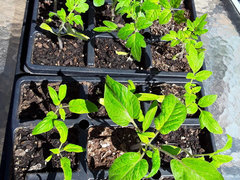
I am wanting to try cantaloupe this year. I have no idea what kind though! I will probably try whatever I run into.
Cat
Mokinu thanked catnohatMokinu
Original Author6 years agolast modified: 6 years agoWe used to grow just 1 to 6 tomato varieties a year (and maybe 2 to 8 plants) when we bought our plants. When I switched to starting from seed, I did ~30 kinds the first year, ~100 the second, ~105 the third, and this year, I'm guessing it'll be between 60 and 80 varieties/plants, after I give some away. I tried to downsize to about 30, but … Maybe another year. I did downsize significantly, though, at least! :)
Mokinu
Original Author4 years agolast modified: 4 years agoSo, in 2018, my tomatoes that turned out to be early for me were a Galapagos Island cross, Frosty F. House, Millet's Dakota, Nodak Early, Mountain Princess, and a Brandy Boy cross (even though it had large fruit). However, my favorites that year were Sausage and the Brandy Boy cross.
For melons, Honeycomb F1 was pretty early for me in 2018. It tasted quite good, too. It was a white honeydew. The Verona watermelon was its usual early.
For peppers, in 2018, I really liked Aji Habanero. It was quite early for a C. baccatum (as well as prolific, vigorous and tasty).
This year, I haven't had my first ripe tomato yet, but Coyote set fruit first, followed closely by a store-bought Early Girl F1 (I grew all the other tomato plants from seed in an unheated 6'x5'x3' greenhouse), and a number of others soon after that. Coyote is my fastest growing plant. A lot of tomato varieties have set fruit by now. I'm growing 40-something tomato varieties, and 80-something tomato plants, this year. It should be noted that the plants weren't all the same stage of maturity when transplanted (and they weren't all transplanted at the same time).
I'm trying Hearts of Gold melon, this year, interestingly (and it was the first melon to flower).
My first pepper to flower this year (in the ground, with mulch) appears to be Neapolitan.
digit (ID/WA, border)
4 years agoHi Shule!
I continue to have some Coyote problems. The fresh seed from 2018 didn't germinate well. A good percentage finally emerged but they were behind the other varieties and will be a bit late this year. It's almost as tho this variety may be best left to its own devices, as a volunteer. However, I can't trust the tractor guy and his tiller!
My Bloody Butcher starts bloomed and developed some tomatoes before it was time to set them out. It isn't a good idea but I left the fruit on them - my Bloody Butcher transplants will each have one or two ripe fruits soon. It will likely be relief to the scraggly little plants to be relieved of those fruits so that they can make some growth!
Life in 2019 has been a little to difficult for the melons and most everything in the open garden. Too much wind, a lot of low temperatures and yesterday - a hailstorm! I am seeing next to no growth from the melon transplants.
SteveMokinu thanked digit (ID/WA, border)Mokinu
Original Author4 years agolast modified: 4 years agoHi Digit! :)
I hope things work out better with Coyote for you.
I have two Coyote plants. One is a cutting of the other. The main plant is huge. It's my fastest growing tomato plant (out of about 80-something plants). I hope it ends up getting a lot of fruit. It's looking like the first fruit that it set might ripen some day soon. The cutting is a small plant that is looking like it might put a growth spurt on soon (but it hasn't quite done it yet).
I'm growing Bloody Butcher, too (for the first time). That was one of the first ones to set fruit for me. It was doing better than it is now, but it's still setting new fruit; so, I'm not complaining.
This year seems to be a pretty good one for the plants in our garden. We've had some colder periods and dips than usual, but the plants actually seem to like it (as in they're growing faster).
I think the Marion tomato has the largest fruit, so far.
My Ginger's Pride melon (which may or may not be a cross), from saved seed, set a fruit. I'm pretty excited about it (I like Ginger's Pride quite a bit). It was the first to do so. However, Hearts of Gold suddenly has lots of female flowers! If many of them set fruit, then, wow. Kirkman (from saved seeds from one of my fruits) had impressive germination this year in every soil and temperature I tried it in. The plants are getting pretty big and nice, too (they're taller than a lot of melons; I wonder if they crossed with Torpeda, which also has this habit; that could be a great cross, for those wanting to breed large melons). Anyway, Kirkman seems to be a great candidate for a good melon to start in an unheated 6'x5'x3' greenhouse (plus, it tastes pretty nice and keeps well, too).
The watermelon are starting to flower.
nbm1981
4 years agolast modified: 4 years agoI have some decent sized tomatoes growing on my Manitoba and several dwarf varieties (Orange Hat, Pinocchio and Birdie Rouge) all have beautiful cherry tomatoes blushing now. Beaverlodge Plum has also set some fruit. The pepper plants, particularly the Emerald Fire and Mucho Nacho jalapenos, Ancho San Luis, Pasilla Bajio and Sweet Banana, are setting numerous fruit, some about ready to harvest.
With the cool and wet spring we've had, I must say I am surprised how well the garden seems to be doing. At least in our immediate vicinity, we've had very little severe weather and the hail we've had has been small and non-destructive. Lots of rain and cool nights, though. My tomatoes aren't far behind last year's extremely warm start and, quite frankly, they look healthier and much less stressed. By this time last year I had lost 4 or 5 plants and replaced a couple of others; none so far this year. All of the tomato and pepper plants are flowering with the aforementioned plants already setting fruit. The peppers are a little behind last year because they obviously love the heat, but the plants appear healthier after a rather anemic start.
I am somewhat regretting not starting melon this year, but with the cool and damp start, getting motivated to do more than the usual was difficult. Next season I will try Kajari again, which I grew in 2016 and was a gorgeous melon and perfect for one or two people. I don't recall the flavor much, but I do believe it was mild and very much like honeydew. I think it was about 100 days before I got the first melon. I also have seed for Charentais, which I have yet to grow, but hear is excellent. I will plan to try it next season. I have seeds for about a dozen varieties of melon, but because my partner is severely allergic, I tend to either forget I have the seeds or over-plant other seedlings.
Mokinu thanked nbm1981Mokinu
Original Author4 years agolast modified: 4 years ago@nbm1981 I'm growing Charentais, this year. Growing it in 2019 was a spontaneous decision (from a few seeds I traded for years ago), but they germinated, and I've got at least one vigorous plant. I was initially surprised at how vigorous it was (based on what I had read about Charentais).
I'm growing some of the same peppers as you: Ancho San Luis (first year) and Sweet Banana (we've grown it before with good success).
I've grown the Manitoba tomato before, twice. The first year it did reasonably well, but the second year, I think it didn't like the spot I had it in combined with the use of black plastic (which I didn't use the first time). It probably wasn't mature enough when the heat set in (that's what I'm thinking). Had I saved seeds and grown them this year, I'm guessing it would have done well.
One I really like this year is Nodak Early. It's more vigorous than last year. Last year it only got a few early good-sized fruit, on a tiny plant. This year it's bigger and more productive. I hope it still gets good-sized fruit! It wasn't as acidic as Manitoba, Mountain Princess, New Yorker V, Sasha's Altai, and such, though. I think it was fairly meaty, too.
nbm1981
4 years agolast modified: 4 years ago@Shule I'll be curious to see what your thoughts on Charentais are. I love growing melon, but have only done so two seasons. My best producer was Hearts of Gold cantaloupe that produced 6 3-4lb melons on one vine. They were amazing. Other unique melons produced a few per vine, but that was a memorable grow, for sure. 2015, I believe.
Sweet banana always performs well for me. I love pickling them. I also eat a few fresh here and there while tending the garden. I love them right off the plant. First time for Ancho San Luis for me, as well, but it is setting several fruit and I'm looking forward to seeing how it produces. I am getting antsy for the season's first chiles rellenos.
First time growing Manitoba. I have it in a whiskey barrel with about 9 micro tomato plants, so I don't expect it to grow to its full potential. It has about a dozen golf-ball sized tomatoes on it now. I have the barrel right up against the house (full southern exposure) and it will get brutal sun all season long. Most warm season plants I put in that area do very well despite the searing heat. Manitoba seems to be doing very well so far.
Never heard of Nodak Early. Please post updates as the season progresses!
Mokinu thanked nbm1981Mokinu
Original Author4 years agolast modified: 4 years agoHere's a picture of my Charentais melon, today. It was initially one of the most vigorous, as I said, but now all the other plants with as much sun are bigger. I didn't pay attention to that fact until today. The upper right and left corners are perhaps parts of other melons.
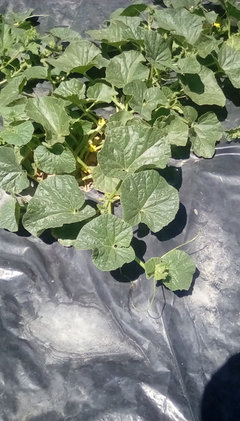
Here's a picture of the two largest plants (Healy's Pride and one of the Kirkman melons; although they may not look particularly larger than Charentais in the photos, they're quite a bit bigger).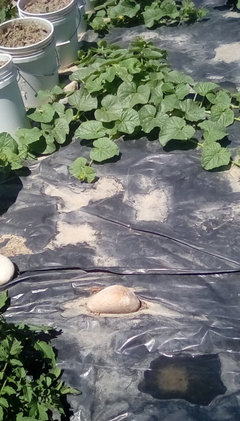
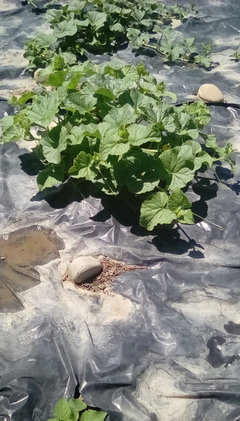
Mokinu
Original Author4 years agolast modified: 4 years agoHere are pictures of my Ancho San Luis, followed by four Sweet Banana peppers:
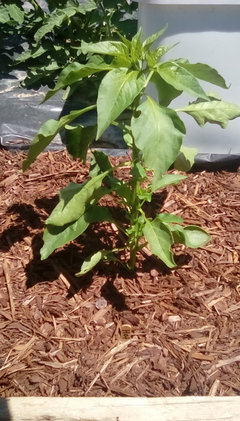
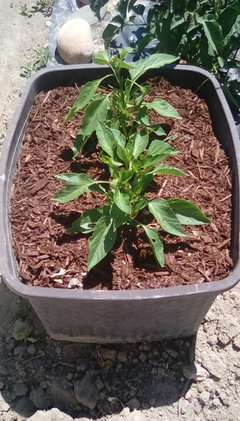
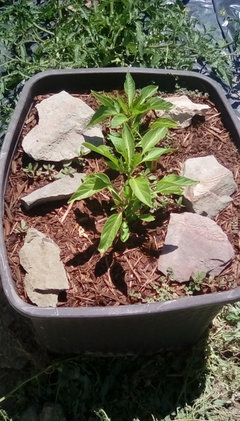
They're all doing moderately well. There are other peppers with bigger and smaller plants.digit (ID/WA, border)
4 years agoI just have to say that putting information about those 90 day melons in a thread titled "Earliest ... Melons" seems designed to create envy!
Okay, it has worked. I'm envious ...
Great pictures and I will be interested (and, hopefully, envious ;o) to learn how the melon (tomato, pepper) season progresses.
SteveMokinu thanked digit (ID/WA, border)Mokinu
Original Author4 years agoSorry, Steve! I was just trying to show the contrast between my biggest plants and Charentais, but it didn't work very well. I was hoping you'd like them, though, since they're some of the most vigorous I've had, yet. I think that photo cut off part of Charentais. Here's a better picture of Charentais, between Hearts of Gold (left) and a volunteer (right):
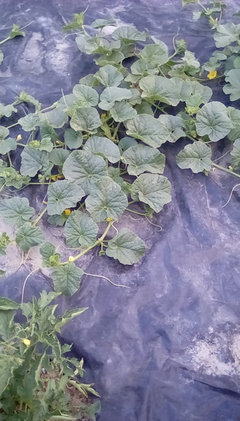
Yeah, Kirkman and Healy's Pride weren't early last I grew them. I'm wondering if some acclimatization will change the days to maturity. Those two are potentially hybrids this year, anyway, though, since they're from my saved seeds, and I grew different kinds together.Mokinu
Original Author4 years agolast modified: 4 years agoSpeaking of the volunteer,
I think I found a great way to grow muskmelons: just put a pile of seeds from a fruit you grew where you want them to volunteer next year. That's kind of what I did with our volunteer here. It's not behind those I started in the greenhouse. I don't know if that would work as well in every year, though.
Mokinu
Original Author4 years agolast modified: 4 years agoWow. Our forecast is surprisingly temperate for the end of June and beginning of July. My usual strategy of planting so many kinds of plants not-so-far apart may have interesting results, this year, since they grow huge when it's not super hot. I need more tomato cages. I don't plant them as close as I used to, though. The muskmelons have more room than most things.
Mokinu
Original Author4 years agolast modified: 4 years agoEarly Girl F1 is already about as big as our plant was in October in 2014! Black Vernissage is pretty small, though, so far.
Mokinu
Original Author4 years agolast modified: 4 years agoLooks like we don't have an extra early tomatoes, this year. Coyote probably would have been ripe a few days ago, but I noticed that the most mature fruits were quite soft (even though they were mostly green). So, I harvested them. They weren't ripe; they tasted like green tomatillos. Early Girl F1 still isn't ripe either, nor the others.
Ginger's Pride has the largest fruit among the muskmelons, so far (and it's setting a number of them). Honeycomb F2 (the F1 was an early melon) was cross-pollinated by Torpeda, apparently, and has two sizeable fruits growing; they look like Torpeda melons (shape, pattern and all). It looks more like Torpeda than Torpeda does.
Charley's Pride is setting lots of fruit. They have a unique appearance.
I think Hearts of Gold just has one fertilized fruit, so far (even though it had lots of female flowers). It also seems to have suffered more from weather changes than the other melons. I gave it and its row of melons some extra nutrients to help them out.
Torpeda set at least one fruit. It looks like a long turban squash! I don't know what happened. It's a melon with a turban. Awesome.
Iroquois set fruit.
The volunteers (three plants in one spot) have several fruits that are coming along nicely. One plant is part Metki Dark Green Serpent melon, apparently (it must have cross-pollinated Noir de Carmes, since I believe there were Noir de Carmes seeds there, and one of the other volunteers looks like Noir de Carmes).
Healy's Pride, Kirkman, Charentais, Huerfano Bliss, and maybe some others haven't set fruit, yet, to my knowledge (or else it's small fruit, or fruit I haven't noticed).
Santo Domingo Winter was the first watermelon to set fruit, followed by Wintermelon. Others to set fruit so far include Verona, the Tom Watson cross, the Weeks NC Giant cross without stars, and the other Santo Domingo type in the SE corner of the patch. The Tom Watson cross and the Weeks NC Giant cross with stars have had the most spider mite damage, so far.
Neapolitan, Hungarian Wax, Chipotle, and probably other peppers have set fruit. I'm very impressed with Chipotle (the tradewindsfruit one).
Most of the tomatoes have set fruit.
We put cages and trellises on some plants.
One of my Nodak Early tomato plants is enormous (and prolific). Last year, it was very small. So, I'm thinking it's a cross.
I think I have a few tomato plants cross-pollinated by Menehune, and I have a suspiscion that Menehune has the rumored recessive regular leaf gene (recessive to PL). The leaves do look different on Menehune than other regular leaf tomato plants.
I get the feeling my Black Beauty tomatoes were cross-pollinated by cherry tomatoes (possibly Sweetie).
Mokinu
Original Author4 years agolast modified: 4 years agoWe've had some ripe tomatoes, now. Coyote would have been about 52 days, but I harvested the fruits too early (they were soft, but still mostly green).
Gnocchia di Limone ripened in about 58 days, but it ripened red, and IMO is slightly bigger than a cherry. So, it's likely an accidental cross.
Early Girl F1 took about 61 days.
I'm calculating days from the transplant.
digit (ID/WA, border)
4 years agoI'm harvesting tiny handfuls of tomatoes.
The Bloody Butcher might have been earliest but I have a confession. They were the earliest but the 2 plants had set fruit before they were transplanted out. I left those green tomatoes on the vines. Weelll, I know better and will usually even take flowers off at transplant. These just so impressed me with their earliness. Besides, they are a very good tasting, early variety!
Stunted the vines! Didn't even get the tomato to ripen on one plant. It split bad and began to decay. So, the 2 Bloody Butcher have had to recover. Meanwhile, it's the Sungolds, one or two Sweet 100's, and Yellow Jelly Beans. Just a few, each day ...
I want to comment on one of Shule's melons. Most, I know nothing about and suspect that they are heirlooms that I might have avoided because I suspected that they wouldn't be early enuf. Hearts of Gold, I'm distantly familiar with.
Several crops were grown here that are only a distant memory for some of the older residents. When I arrived in the 60's, Hearts of Gold was one of these. It may be that I never ate one. They were a farm crop on a few of the valley farms. Besides shopping at supermarkets, I was making regular drives back to a previous home in Oregon those days. That trip would take me through Umatilla, a center for melon growing in eastern Oregon. I mean, they had Crenshaw melons and Casaba in their fruit stands. It was easy for a young guy to overlook a variety that soon passed into this area's farming history.
SteveMokinu thanked digit (ID/WA, border)Mokinu
Original Author4 years agoHere's my Hearts of Gold, so far (the larger of the two fruits that have set, so far).
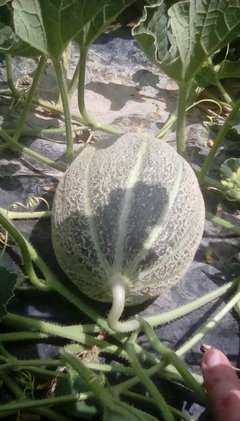
Mokinu
Original Author4 years agolast modified: 4 years agoMy favorite muskmelon, so far, this year, is Honeycomb x Torpeda! It's big, early-to-set, attractive, smooth, and well-formed. The plant is nice and healthy. I'm looking forward to finding out what they taste like, and how big they get. Honeycomb F1 was white and smooth outside; it was an early, good-sized, tasty honeydew that I recommend. I want to try more Honeycomb F2s next year. The stripes come from Torpeda (and they're the reason I know it's a cross with it).
While regular Torpeda hasn't been what I would call late in my garden, I understand reviewers with colder frost-free growing seasons than mine thought it needed more heat to do well. This year, it has two fruits set, so far (but they're younger than those of the Honeycomb cross; one has a turban on it, though!)
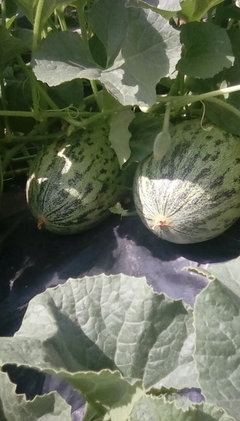
Mokinu
Original Author4 years agolast modified: 4 years agoMy Matt's Wild Cherry is the third kind of tomato in the garden to start to ripen, but, it looks like it's ripening yellow! It must be a cross. It looks just like Coyote did when it started to ripen. I thought it was Coyote, actually, until I followed the stem to its plant (they're right next to each other).
Bloody Butcher has plenty of fruit, but I haven't had ripe ones from it, yet. I did harvest a green fruit and seed it, though (there weren't many seeds that were ready, however, but it was astonishingly meaty).
The Gnocchia di Limone cross fruit was really good.
Mokinu
Original Author4 years agolast modified: 4 years agoMy Earliest pepper was Neapolitan. I harvested a green one two or three days ago, which was ripe enough to eat. Haven't had any red ones, yet, of course.
I tried it in a container last year, but it's doing better in the ground, with mulch, this year.
Mokinu
Original Author4 years agolast modified: 4 years agoHere are pictures of Noir De Carmes (the volunteers), including the cross with Metki Dark Green Serpent melon.
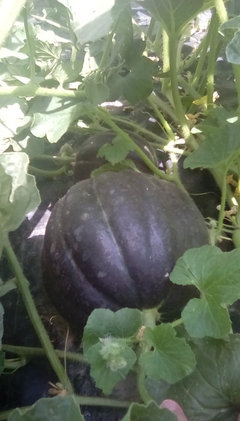
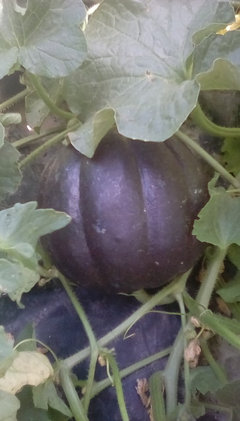
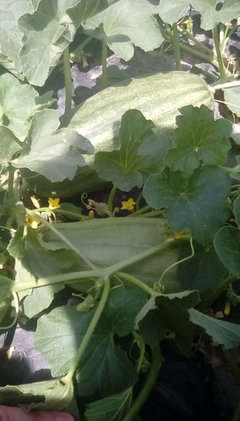
These are the same fruits from the previous picture.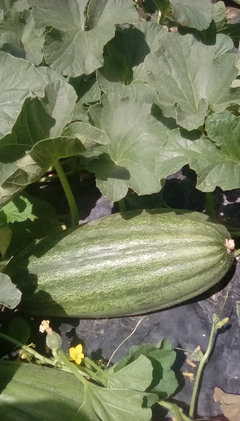
Mokinu
Original Author4 years agolast modified: 4 years agoNot sure if it's a cross, but here's my Torpeda melon (which set fruit in reasonable time), including the fruit with a turban. I'm guessing the Honeycomb cross will be earlier. Only one fruit has a turban, but I got two pictures of it for this post. It doesn't appear to have been properly pollinated, by the shape on the stem end. I don't remember if Torpeda was so furry last year. There's more fur than you can see in the picture easily.

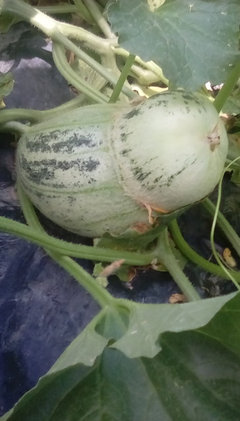
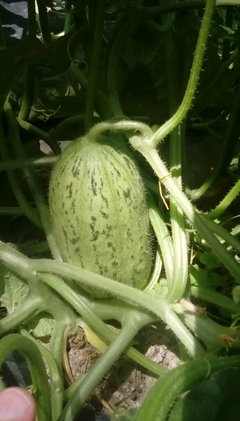
Mokinu
Original Author4 years agoHere are the first two watermelons to set fruit:
I believe this is Santo Domingo Winter (the following two pictures are of the same fruit):
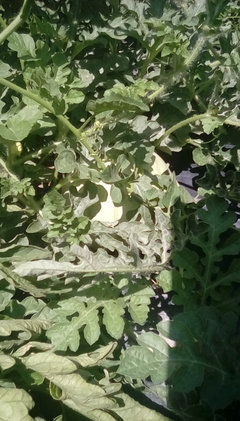
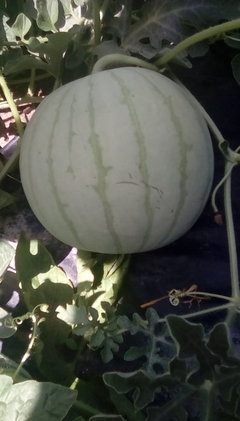
And I believe this is Wintermelon: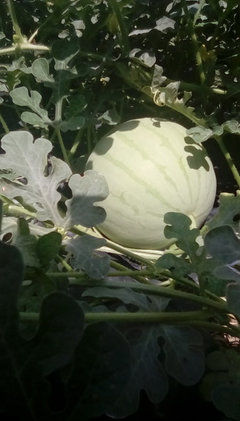
Mokinu
Original Author4 years agolast modified: 4 years agoThe earliest muskmelon was Noir de Carmes x Metki Dark Green Serpent F1 (which tasted awesome, btw), I believe, followed closely by Noir de Carmes, Ginger's Pride, and later what was supposed to be Charley's Pride and Iroquois. The earliest watermelon was Santo Domingo Winter, followed by my Weeks NC Giant cross (which had my largest fruit in the garden at the time, at least), two Veronas, a Congo cross, and two more Santo Domingo Winters. My earliest fully ripe pepper was Neapolitan. My earliest tomato was probably a Gnocchia di Limone cross. My Honeycomb x Torpeda melons might be ripe now, but I'm not sure.
The Marion tomato was early for its fruit size. The plant from fruit B was the earliest of my Brandy Boy crosses, and a plant D with BER, followed by plant G and more ripe fruits on plant B. there may be others (but I didn't check enough).
Many early tomato varieties were not early this year.
Mokinu
Original Author4 years agolast modified: 4 years ago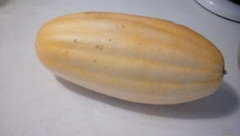
This is the first ripe muskmelon. Exceptional flavor. It was sweet, and had good meaty texture despite being half Armenian cucumber: i.e. Metki Dark Green Serpent. It had an initial cantaloupe flavor followed by a surprising burst of awesome and new flavor. It was orange (a lighter orange) inside. I was surprised that the rind went from green to white to yellow. I'd never heard of that, but it's awesome. :) The fruit smelled good when ripe, before cutting it open. The plant was a purposeful volunteer (I put a pile of seeds in that location last fall).
Mokinu
Original Author3 years agolast modified: 3 years agoThis year, my earliest tomato, out of about 90-something varieties (including a number of cherries), is Galapagos Island (Solanum cheesmaniae). It's a very early, yellow/gold, indeterminate (but thin-stemmed), regular leaf, cherry tomato, with roundish, slightly ovate fruit. The fruits range from marble-sized to about twice that size (depending on the soil, perhaps). The plants seem to grow much larger when given black plastic. It's prolific, hardy, and heat/cold/drought-tolerant.
I got my original seeds from wintersown.org in the fall of 2014. I'm not sure where they got them.
My tomatoes are later than average, this year (they're about a week later than expected from previous years' experience, probably due to the cooler and rainier weather we've had this year). However, the tomatoes are looking quite prolific, this year!
Mokinu
Original Author3 years agolast modified: 3 years agoMany watermelons have set fruit. I'm not sure which kinds they are, but probably Santo Domingo Winter hybrids are among them.
My most vigorous muskmelon plant, so far, is my Honeycomb x Torpeda F3. Germination was excellent on that one, too. The other Honeycomb types are different. A volunteer muskmelon is pretty vigorous, too, as is my Noir de Carmes x Metki Dark Green Serpent F2.
The muskmelons I'm growing, this year, include these:
* Honeycomb x Torpeda F3 (plants in two locations)
* Honeycomb F2
* Honeycomb x Ashkahabad? F2
* Noir De Carmes x Metki Dark Green Serpent F2
* Charley's Pride offtype
* Unknown volunteer
* Orange Flesh Honeydew
* Conoe Creek Colossal
I'm not growing Kirkman, nor Torpeda, this year. Kirkman was pretty late, last year, and it didn't have a winter muskmelon type shelf-life.
Absolutely all of my watermelons and muskmelons are from saved seeds (or else are volunteers), this year.
Some of my peppers set fruit by a day or two ago. I'd have to look up what kinds they are, but there's at least one Pepperoncini type that has set fruit among them.
Watermelons I'm growing include at least these:
* Santo Domingo Winter
* Santo Domingo Dark Green
* Santo Domingo Brown Seeded
* Navajo Red
* Navajo Winter
* Weeks NC Giant crosses
* Wintermelon
* Winter Queen
* King Winter
* Carolina Cross #183
I'm not growing Verona, nor the Congo types, this year (although it's possible they cross-pollinated something).
Based on previous years, the earliest watermelons to get ripe might be Santo Domingo Winter, followed by Weeks NC Giant crosses, Santo Domingo Dark Green, and Carolina Cross #183, in no particular order. However, with probable cross-pollination, things are less sure than they otherwise might be.
I expect the earliest muskmelon might be either the Honeycomb F2 or the Honeycomb x Torpeda F3, or possibly Noir de Carmes x Metki Dark Green Serpent F2.
digit (ID/WA, border)
3 years agoHi !
The name change threw me but as I was re-orienting myself, I went back and reread the posts over the last two years. Lots of names there, too.
It's good to see that you are still trying the new and confirming the old. Yes. Each year is different and resting on laurels doesn't make for sure success.
Yes, we must be able to change our names. When Gardenweb became Houzz, I had trouble signing in. So, I opened a new account under the name of Stevedigits. Thinking that I probably shouldn't have done that, I was relieved to learn that I could choose a different handle. (In a way, David52 suggested the image that I use ;o)
A new-to-me melon variety this year is Petit Gris de Rennes melon. It's much too early for me to guess how it's doing ... the plants are very small. I wonder if it isn't as much from too much wind nearly daily, as the cool temperatures.
SteveMokinu thanked digit (ID/WA, border)Mokinu
Original Author3 years agolast modified: 3 years agoI think I tried to grow Petit Gris de Rennes once (probably in 2015). If I remember right, it was quite delicate compared to some melons. I believe I gave my plant to a neighbor, who grew it, and my neighbor's description of the results wasn't impressive enough for me to grow it the next year (granted my neighbor probably didn't give it any potassium or such). I think I read that it tastes like brown sugar or something like that. My guess is that it would appreciate more organic matter and humidity than your average cantaloupe, but I could be wrong. If it were me now, I would probably give it extra phosphorus (monopotassium phosphate), although I wouldn't have done it in 2015. Phosphorus should help with cold-tolerance, plant maturity, leaf size, and flowering. If I were feeling adventurous, I may also give it some Epsom salt and zinc. If your soil has a low amount of zinc, zinc might speed up the growth. I've noticed benefits from adding zinc to our soil before (with peppers, at least).
digit (ID/WA, border)
3 years agodigit said: A new-to-me melon variety this year is Petit Gris de Rennes melon.
I thought that I would come back and post a picture of a mature melon: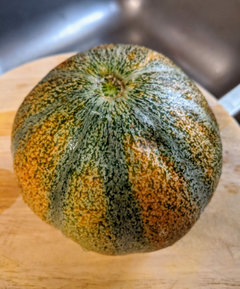
This was fully ripe. I was told that they should begin to change color from the green, so I waited. 2+ pounds. Small (hense the name, Petit), it is a very flavorful "true cantaloupe."
It wasn't until well into the season that I learned that it is an 85-day melon. Oops.
Despite pumpkins and squash having a very good year, it wasn't wonderful for the melons but I harvested the last of the Passport Galia about a week ago. All of the Goddess cantaloupe have now been eaten. There were only 4 Petit Gris de Rennes and there are still 3 out there. ~ NOT a very early melon ~
SteveMokinu thanked digit (ID/WA, border)Mokinu
Original Author3 years agolast modified: 3 years agoMy melons haven't done well, this year. I think it's because I didn't give them any potassium, this time—that and the squash bugs spread to them from a nearby squash that historically had not attracted lots of squash bugs. We got at least one fruit we can eat, but we haven't eaten it, yet.
The watermelons did well by comparison, but not as many fruit as previous recent years. My earliest watermelons seemed to be my Weeks NC Giant crosses, and Santo Domingo Dark Green. They were also among the largest, but they weren't large. I had watermelons in the same spot in 2018. I imagine Santo Domingo Winter was among the earliest, too, but I didn't harvest all the ripe fruits at once, because someone else compelled me to leave them outside until we ate the ones I picked. It's definitely better to bring them in as soon as they're ripe, though!
I'm excited for next year's watermelon. I definitely want to put the muskmelons in a different spot next year, and avoid growing any squash anywhere close to near them.
Mokinu
Original Author3 years agolast modified: 3 years agoIt was a much better tomato year. My earliest was Galapagos Island. Esterina F1 and a volunteer that might have been Mountain Princess were next. My earliest beefsteak was probably BSX.
Mokinu
Original Author3 years agolast modified: 3 years agoHowever, my best overall producing tomatoes were these, in no particular order:
* Galapagos Island
* Napoli (not early; most are still ripening)
* Napoli crosses (much earlier than Napoli, with larger fruit)
* Insurance_1 (a big, pink beefsteak)
* BSX (and early-ish black beefsteak)
* Japanese Black Trifele
* Isis Candy (early, with fruits bigger than cherry-sized)
* A Nodak-Early-like volunteer
* Frittata Kitchen (early-ish)
* Porter
* A Purple Calabash cross (probably with Costoluto Genovese; it has deep red fruit and looks like Purple Calabash otherwise; regular Purple Calabash did not produce nearly so well)
* Sprite
* Maybe a few others, like one of my Brandy Boy crosses (that one was the latest of the Brandy Boy crosses, but very good tasting)
The best-tasting were probably these (in no particular order; only the ones I've already mentioned as early were early):* Cold Black Brandy
* Cherokee Yellow Red Pear
* Yellow Plum
* Cherokee Yellow Perfection Peach
* Esterina F1
* Garnet
* Galapagos Island (it tasted pretty great, this year)
* Carbon
* That aforementioned Brandy Boy cross
* Blue Berries
* Amana Orange
* Sprite
* A Pink Ping Pong cross (red)
* Frittata Kitchen (for culinary uses; not fresh)
* Porter
* Chocolate Chestnut
* Rosella
* Black Cherry (late germination/transplant)
* SunChocola F2 (late transplant/start)
* Austin's Black Cherry
* Eva
Mokinu
Original Author3 years agoI think my earliest pepper was Pepperoncini Greek Golden (but it ripened red). Aji Habanero was pretty early, too. I haven't harvested many peppers, yet. So there are a lot of ripe ones on the plants. I'm planning to dry and powder them.
Next year, I plan to make all of my Capsicum annuum peppers sweet peppers, and work on breeding prolific sweet peppers. I'm planning to grow lots of orange sweet peppers. I still plan to grow a few C. baccatum and C. chinense peppers, though.
I want to breed an early orange sweet pepper shaped like Lipstick.
Mokinu
Original Author3 years agoThese tomatoes handled early season freezes before the transplant the best, if I recall correctly:
* Insurance_1
* BSX
* Isis Candy
* Chadwick's Cherry (this was decent overall)
digit (ID/WA, border)
3 years agoSuch Variety!
Mokinu, it is, I guess, not surprising that I have managed to grow just a few out of that list. DW likes mild tomatoes and once said that Porter was a favorite. My grandmother evidently liked Porter as well and I had the seeds from her through my uncle - years ago. It's a useful choice.
Isis Candy, I have grown. I no longer remember how much it tasted like candy but, to me, Sungold and Sun Sugar certainly do. That's okay but I like some of that "tomato" flavor in the other cherry tomatoes.
And, we got 'em! It's been a very, very productive season in the tomato patch. Baskets full of cherries have come off the plants. They weren't especially early. In fact, the beefsteaks have been LATE this year. The only way I can account for that is that it's because the plants grew large and set plenty of fruit.
I suppose that if I wanted to hurry them along that I should have done some pruning, both of vines and fruit. Really, there were very few larger tomatoes until this month. In fact, there are more ripening on the plants right now than have been harvested! For the most part, the patch is made up almost entirely of ~ officially ~ under 75-day varieties. Late harvest and some years this would not have worked well. And, it has been a much shorter harvest season that I would have liked but tomato abundance is now mine!
SteveMokinu thanked digit (ID/WA, border)


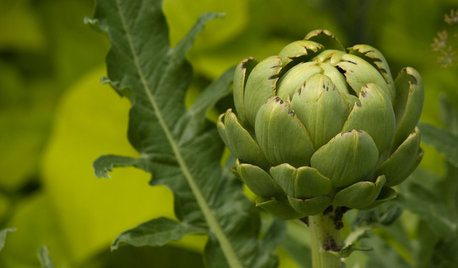



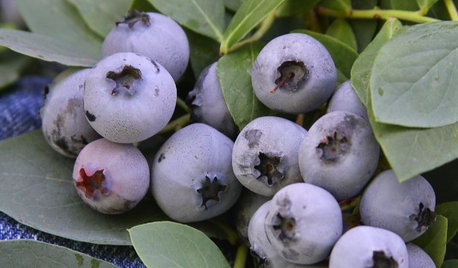
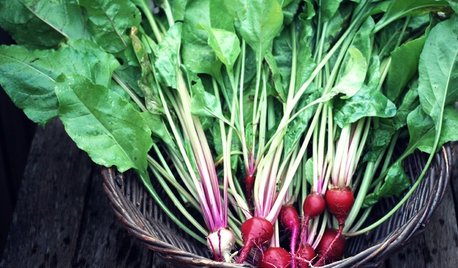






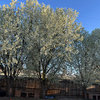
digit (ID/WA, border)